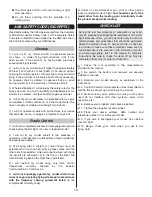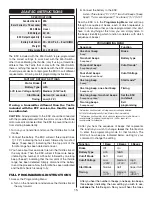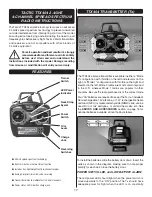
18
Anytime the LED begins to fl ash, accompanied by the
sounding of an audible tone, the Tx battery voltage has
dropped too low
and operation of the model should NOT
be attempted!
WARNING!
Never operate an R/C model
with weak Tx batteries! Reduced operational
range and/or possible loss of control of the
aircraft could result. Replace weak alkaline
batteries, or re-charge NiCd or NiMH batteries before
attempting a fl ight!
If during a fl ight the Tx LED starts to fl ash, accompanied
by the sounding of audible tones, it’s a warning that the Tx
batteries have become weak and the aircraft should be landed
as soon as possible!
AILERON (CH1)
Controls the moveable surfaces at the end of both main wings
to rotate the airplane about the “roll” axis (an imaginary line
which extends from the airplane’s nose to the tail). Since
every airplane is different, the aileron reversing switch must
be set so that moving the aileron stick to the right will cause
the airplane’s right aileron to defl ect up, thus causing the right
wing to drop and the airplane will bank to the right. Moving
the aileron stick to the left will cause the airplane’s left wing to
drop and the airplane will bank to the left. This is one important
method for turning the aircraft.
ELEVATOR (CH2)
Controls the moveable horizontal surfaces on the airplane’s
tail to rotate the airplane about the “pitch” axis (an imaginary
line extending through the center of both main wings, from one
wing tip to the other wing tip). Position the elevator reversing
switch so that pulling the elevator stick back (towards you)
will cause the elevators to defl ect up, thus causing the nose
of the airplane to rise. Pushing the elevator stick forwards
(away from you) will cause the nose of the airplane to drop.
When using the ailerons to bank the airplane’s wings, pulling
the elevator stick back will help the aircraft maintain altitude
and turn the aircraft more quickly.
THROTTLE (CH3)
Controls the speed (R.P.M.) at which the engine or electric
motor operates. With the throttle reversing switch in the NOR
position, pulling the throttle stick back will cause the engine’s
speed to decrease. Pushing the throttle stick forward will cause
the engine’s speed to increase.
RUDDER (CH4)
Controls the sideways movement of the airplane’s tail and
will rotate the airplane about the “yaw axis” (an imaginary
line from the top of the airplane’s fuselage to the bottom of
the fuselage, located near the center-point of the fuselage).
Position the rudder reversing switch so that moving the rudder
stick to the right causes the rudder to defl ect to the right, thus
causing the nose of the airplane to point to the right. Moving
the rudder stick to the left will cause the nose of the airplane
to turn left. When using the rudder in conjunction with the
ailerons, the airplane’s nose can point into a turn (instead
of pointing up and “skidding” through the turn), allowing the
airplane to perform tighter, more coordinated turns.
TRIMS
A “trim” lever is included for each of the main controls, located
adjacent to the respective stick.
The aileron, elevator, and rudder trim levers are digital in
function, and always rest at center position. Briefl y defl ecting
the lever to either direction away from center will cause the
respective servo output to fi nely rotate to one direction, and
will be accompanied by an audible tone. Pressing and holding
the trim lever will cause the servo output to move repeatedly.
During a fl ight, when the main sticks are released and spring
back to center position, the aircraft should ideally not veer in
any direction. If the aircraft does veer in a particular direction,
click the respective trim lever until the aircraft maintains a
straight attitude on its own.
The throttle trim lever is analog in function, and can move
mechanically up or down and rest at any point in the range.
Moving the throttle trim lever slightly up or down will fi nely
adjust the engine or motor at low speeds. For safety reasons,
it’s a good idea to use throttle trim when controlling the engine/
motor at very low speed while on the ground. For aircraft with
glow engines, the precise position of the trim lever is helpful
when determining the engine’s preferred idle point. The throttle
trim lever is not active when the main throttle stick is above
the center point.
REVERSING SWITCHES
Four reversing switches are built into the Tx, one for each
control. Each switch can reverse the rotational direction of
the servo that is connected to the respective channel. This
is often a much easier method for changing the direction of
a servo’s movement as opposed to altering the mechanical
connections between the model’s surface and the servo. Refer
to the model’s instructions for specifi c details.







































